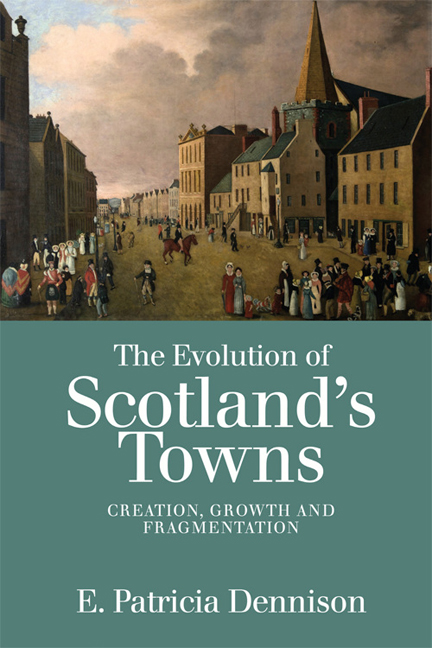Book contents
- Frontmatter
- Contents
- List of Figures
- Acknowledgements
- Image Credits
- List of Abbreviations
- Introduction
- 1 Medieval Towns
- 2 Daily Life in the Middle Ages
- 3 Medieval Faith and the Church
- 4 Encroachment on Burgh Society, 1550–1750
- 5 Man-made and Natural Disasters, 1550–1750
- 6 The Birth of Urban Scotland
- 7 The Victorian Town
- 8 The Twentieth Century
- Post-script: Footprints to Fragmentation
- Appendix: Population Statistics – A Select List
- Bibliography
- Index
Appendix: Population Statistics – A Select List
Published online by Cambridge University Press: 11 November 2020
- Frontmatter
- Contents
- List of Figures
- Acknowledgements
- Image Credits
- List of Abbreviations
- Introduction
- 1 Medieval Towns
- 2 Daily Life in the Middle Ages
- 3 Medieval Faith and the Church
- 4 Encroachment on Burgh Society, 1550–1750
- 5 Man-made and Natural Disasters, 1550–1750
- 6 The Birth of Urban Scotland
- 7 The Victorian Town
- 8 The Twentieth Century
- Post-script: Footprints to Fragmentation
- Appendix: Population Statistics – A Select List
- Bibliography
- Index
Summary
The population figures for 1801 onwards are based on the ten-yearly series of official census records. The data for 1755 derive from the survey conducted by the Rev. Alexander Webster, published in abbreviated form in J. G. Kyd (ed.), Scottish Population Statistics including Webster's Analysis of Population 1755 (SHS, 1952). Care has to be taken, however, to distinguish between burgh and parish, which is not always evident in Webster's returns; where doubt exists or there is an element of implausibility no figure has been listed. Where figures are cited, they are likely to overestimate by some extent the size of the burgh itself. The figures for Glasgow include the Barony parish, together with Govan and Gorbals. The figure for Paisley in 1755 includes only the burgh as the expansion of the town across the river in the Abbey parish came only after c. 1780. The figure for Abbey parish in 1755 was 2,509, giving a combined total of 6,799. That for 1801 includes both the burgh and the Abbey parish.
The same criteria about burgh and parish apply in citing the data for 1691, which derive from a mathematical calculation based on hearth tax returns. These are as summarised in I. Whyte, ‘Urbanisation in early modern Scotland: a preliminary analysis’, Scottish Economic and Social History, 9 (1989), 21–37. There are minor, and more correct, variations in a similar exercise based on hearth tax returns: M. Lynch, ‘Urbanisation and urban networks in seventeenth century Scotland: some further thoughts’, Scottish Economic and Social History, 12 (1992), 24–41. The figure for Edinburgh in 1691 is an approximate one, based on the evidence collated in H. M. Dingwall, Late Seventeenth-Century Edinburgh: a Demographic Study (Aldershot, 1994). It and the subsequent figures include Leith and Canongate. These figures may be at variance with some in contemporary reports and estimates or figures used or calculated by modern historians. This highlights the intrinsic problems of devising precise population figures.
Population figures before 1691 are notoriously difficult to guess. The ‘long century’ between 1500 and 1650 did see an increase in numbers but, before this time, apart possibly in the case of Edinburgh, people in towns would have numbered only a few hundred (see pp. 15, 32, 44n.106, 52).
- Type
- Chapter
- Information
- The Evolution of Scotland's TownsCreation, Growth and Fragmentation, pp. 299 - 300Publisher: Edinburgh University PressPrint publication year: 2017



